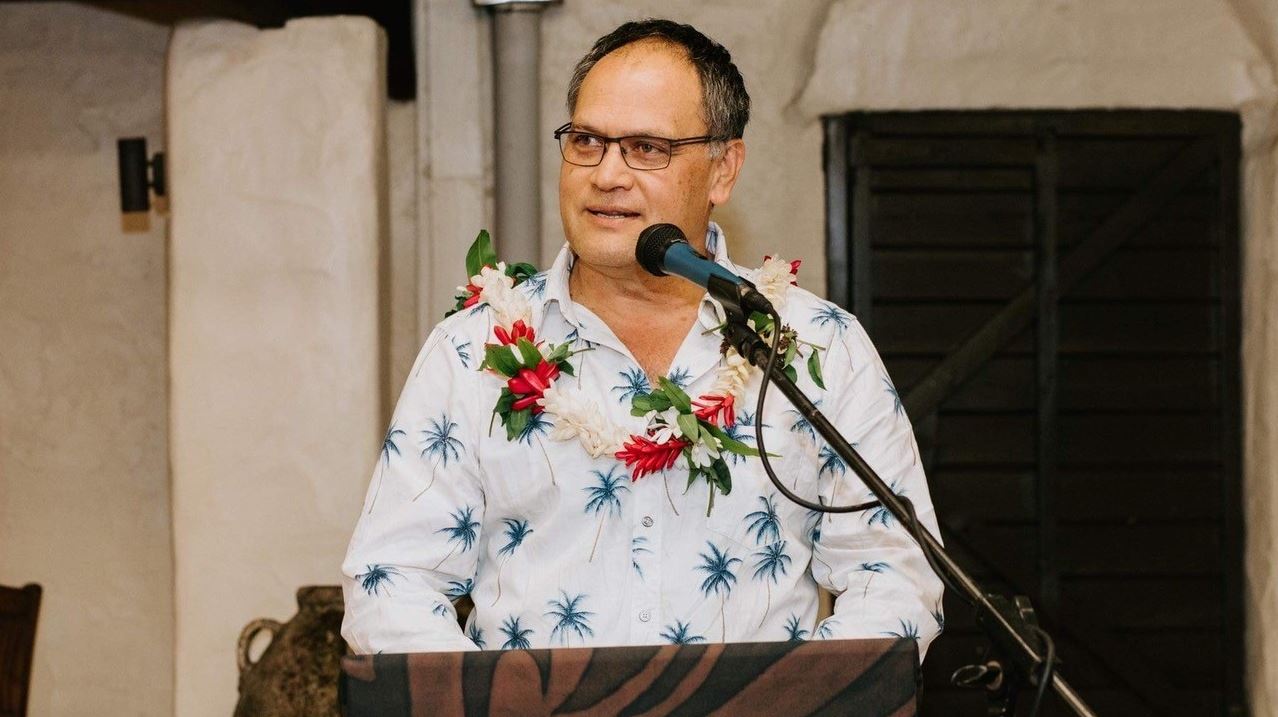‘Art is not just about painting or sculpting, it’s everything we do’
Saturday 16 July 2022 | Written by Supplied | Published in Features, Weekend

Keynote speaker Dr. Kiki Maoate. Picture: Zeman & Co./22071506
Pacific artist of Samoan origin Fatu Feu’u returned to exhibition in the Cook Islands accompanied by contemporaries and fellow Samoans Andy Leleisi’uao and Raymond Sagapolutele with a new series of work including paintings, prints and photography at the Bergman Gallery.
The exhibition Fa’atasi which opened on Monday and will run until August 6 acknowledges the anniversary of Feu’u’s Cook Islands residency.
Cook Islander Dr Tearikivao (Kiki) Maoate, the president of the Pasifika Medical Association, and Bergman Gallery director Ben Bergman were the keynote speakers at the exhibition’s opening.
Bergman says the exhibition is an engaging commentary.
“Set against the backdrop of disruption that has defined the past two years, Leleisi’uao’s six-part series ‘Uslands’ explores his enduring all-inclusive portrait of an alternative utopia while Sagapolutele’s photographs confront systemic racism and cultural evolution within a Pacific/urban context.
Feu’u’s large scale painting Fa’atasi anchors the exhibition, his legacy, mana and spirit of learning together woven into the remarkable free hanging canvas.”

Born in 1946, Feu’u emigrated to New Zealand in 1966, and over the years he has built a well-recognised career as a painter, printmaker and sculptor and is regarded as the godfather of Pacific Contemporary art.
His practice fuses traditional Pacific and Samoan imagery with European modernism, explains Bergman. His regular use of the frangipani flower motif is a trademark and a powerful metaphor for Feu’u’s unification of two visual cultures.
“Stylistically he is influenced by New Zealand artists Tony Fomison, Phillip Clairmont, Alan Maddox and Colin McCahon of whom he had early associations. Samoan patterns, design, legend, traditional language and biblical text also serve as familiar motif within this artists large body of work.”

Feu’u was the Creative New Zealand artist in Residence to Rarotonga in 2002. Co-hosted by the Cook Islands Ministry of Cultural Development, Feu’u’s residency resulted in multiple workshops and exhibitions involving many Cook Islands artists.
“His bright, expressive paintings, vivacious personality and professional public relations skills ignited the developing Rarotongan art community, lending a fresh sense of confidence and resolve,” Bergman shares.
“Over the course of his career, Feu’u has gained regional institutional recognition, his work can be found in Te Papa Tongarewa, The Museum of New Zealand, Wellington; The Auckland Art Gallery – Toi O Tamaki, Auckland and the National Gallery, Brisbane, Australia.”
Explaining his passion, Feu’u says: “To me, art is not just about painting or sculpting. Art is part of everything we do, whether it’s building a house, or the way we talk to our family and friends, something we do with respect.”
Leleisi’uaois a significant Pacific artist living and working in Auckland, New Zealand. Over the past 20 years Leleisi’uao’s style has morphed from highly volatile, expressive paintings and sculpture into sophisticated stories reflecting the artist’s inner space.

Through his more recent work, Leleisi’uao has created alternative universes, emergent societies populated by strange creatures that are free of traditional human prejudice. It is a genesis point, a veritable human reset button.
“The artists influence range is enormous, he draws from ancient and modern history, literary history, art history, pop culture history, world headlines, personal experiences, he rarely leaves a stone unturned. He tells the story of what we can be as a species, regardless of our cultural stature, religious convictions, skin colour or sexual orientation.”
Sagapolutele is an Aotearoa-born Samoan artist with family ties to the villages of Fatuvalu in Savai’i and Saluafata in Upolu, Samoa. He picked up the camera in 2003 and began a self- taught photography journey that would see him work with editorial publications Back to Basics and Rip It Up as a staff photographer as well as submissions to the NZ Herald and Metro Magazine.
Sagapolutele completed his Masters in Visual Arts in 2019, with first-class honours and received the Deans Award for Excellence in Postgraduate study from the Auckland University of Technology (AUT).

Bergman says: “For the artist, the camera has become a vital part of his ability to explore his heritage as a diasporic Samoan with cultural ties that link him to the history of the Pacific and the land within that vast ocean. The camera is how his visual language is given a voice, the method that forms his oratory and connects to the Samoan tradition of Fagogo (storytelling).”
Coming up,Billy Apple, Rainbows 1965 opens August 16th at Bergman Gallery Rarotonga.












































